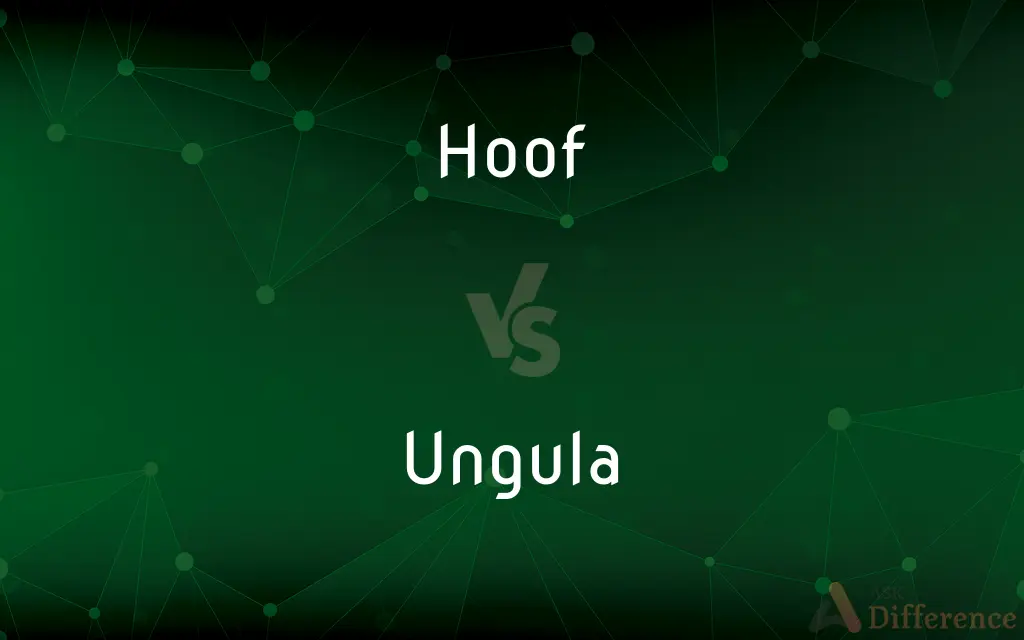Hoof vs. Ungula — What's the Difference?
Edited by Tayyaba Rehman — By Maham Liaqat — Updated on April 2, 2024
A hoof is the hard covering of the foot of certain animals, providing support and protection, while ungula refers to the hoof or a similar structure in other animals, serving as a broader term for such protective foot coverings.

Difference Between Hoof and Ungula
Table of Contents
ADVERTISEMENT
Key Differences
The term "hoof" is commonly used to describe the hard, outer covering of the feet of specific animals, such as horses, cows, and deer. This structure is critical for providing protection against the environment, supporting the animal's weight, and in some cases, aiding in their movement across various terrains. Hooves are typically associated with ungulates, animals that walk on the tips of their toes. On the other hand, "ungula" is a less commonly used term that encompasses not only the hooves of these ungulate animals but also refers to similar structures in other species, including the claws or nails in a broader biological context.
While hooves are a specific type of ungula found primarily in mammals, the concept of ungula can also apply to analogous structures in other animals, showcasing the term's broader applicability. This distinction highlights the evolutionary adaptations across different species, where similar functional needs have led to the development of comparable protective structures for their limbs. Hooves, being a subset of ungulae, are designed for endurance and stability, facilitating movement and providing defense against predators and environmental hazards.
The composition of a hoof includes keratin, a tough protein also found in human nails and hair, which gives it strength and durability. In contrast, the term ungula, by encompassing a wider range of structures, does not specify the material composition, focusing instead on the role these structures play in the animals' physiology and survival. This differentiation emphasizes the functional importance of these structures across diverse animal taxa.
In terms of care and management, animals with hooves often require regular maintenance to ensure their health and functionality, such as trimming and protection from excessive wear or injury. The care for ungulae, in a broader sense, would depend on the specific type of structure and animal, indicating a more varied approach to their maintenance and health. This aspect underscores the practical implications of these anatomical structures in animal husbandry and veterinary medicine.
The study of hooves and ungulae offers insights into the ecological and evolutionary adaptations of animals, reflecting their interactions with their environment over time. The development of hooves as a specialized form of ungula in certain animal groups illustrates the intricate relationship between anatomy, environment, and evolutionary history, highlighting the complexity of biological adaptation and diversity.
ADVERTISEMENT
Comparison Chart
Definition
The hard protective covering of the feet of certain ungulate animals.
A broader term that includes hooves and similar structures in other animals.
Composition
Primarily composed of keratin.
Varies, but can include keratin among other materials.
Associated Animals
Primarily ungulates such as horses, cows, and deer.
Includes animals with hooves and those with similar structures, like claws or nails.
Function
Protection, support, and aiding in movement.
Protection and support, with specific functions varying by animal.
Care and Management
Often requires regular trimming and maintenance.
Care varies widely depending on the animal and specific structure.
Compare with Definitions
Hoof
Requires maintenance.
Regular hoof care is essential for domesticated horses.
Ungula
A term for hooves and similar structures.
The study of ungulae reveals a lot about an animal's evolutionary adaptations.
Hoof
Made of keratin for durability.
The strength of the hoof is crucial for animals' survival in the wild.
Ungula
Varies in composition.
The composition of ungulae can differ significantly among species.
Hoof
The hard covering on the foot of certain animals.
The horse's hoof needed trimming to prevent discomfort.
Ungula
Functionally important for protection.
The ungula serves as a protective layer against harsh terrains.
Hoof
Aids in movement across terrains.
The camel's hoof is adapted to desert environments.
Ungula
Encompasses a broader range of animals.
Both birds and mammals have ungulae, although they vary in form.
Hoof
Found in ungulates.
Deer tracks are easily identified by their distinctive hoof prints.
Ungula
Reflects ecological adaptations.
The diversity of ungulae is a testament to animals' ecological versatility.
Hoof
A hoof ( or ), plural hooves ( or ) or hoofs , is the tip of a toe of an ungulate mammal, strengthened by a thick and horny keratin covering.Artiodactyls are even-toed ungulates, meaning that these species have an even number of digits on each foot. Ruminants, with two main digits, are the largest group.
Ungula
In solid geometry, an ungula is a region of a solid of revolution, cut off by a plane oblique to its base. A common instance is the spherical wedge.
Hoof
The horny sheath covering the toes or lower part of the foot of a mammal of the orders Perissodactyla and Artiodactyla, such as a horse, ox, or deer.
Ungula
A hoof, claw, or talon.
Hoof
The foot of such an animal, especially a horse.
Ungula
(geometry) A section of a cylinder, cone, or other solid of revolution, cut off by a plane oblique to the base; so called from its resemblance to the hoof of a horse. thumb|
Hoof
(Slang)The human foot.
Ungula
(botany) unguis
Hoof
To trample with the hooves.
Ungula
A surgical instrument for use in removing a dead fetus.
Hoof
To dance, especially as a professional.
Ungula
A hoof, claw, or talon.
Hoof
To go on foot; walk.
Ungula
A section or part of a cylinder, cone, or other solid of revolution, cut off by a plane oblique to the base; - so called from its resemblance to the hoof of a horse.
Hoof
The tip of a toe of an ungulate such as a horse, ox or deer, strengthened by a thick keratin covering.
Ungula
Same as Unguis, 3.
Hoof
(slang) The human foot.
Get your hooves off me!
Hoof
An ungula.
Hoof
To trample with hooves.
Hoof
(colloquial) To walk.
Hoof
(informal) To dance, especially as a professional.
Hoof
To kick, especially to kick a football a long way downfield with little accuracy.
Hoof
The horny substance or case that covers or terminates the feet of certain animals, as horses, oxen, etc.
On burnished hooves his war horse trode.
Hoof
A hoofed animal; a beast.
Our cattle also shall go with us; there shall not a hoof be left behind.
Hoof
See Ungula.
Hoof
To walk as cattle.
Hoof
To be on a tramp; to foot.
Hoof
The foot of an ungulate mammal
Hoof
The horny covering of the end of the foot in hoofed mammals
Hoof
Walk;
Let's hoof it to the disco
Hoof
Dance in a professional capacity
Common Curiosities
Are ungulae found only in mammals?
No, ungulae can refer to protective foot structures in a broader range of animals, not just mammals.
Can the term ungula be used interchangeably with hoof?
While ungula can refer to hooves, it is a broader term that also includes similar structures like claws and nails.
How does the structure of a hoof benefit an animal?
The structure of a hoof provides durability, support, and protection, aiding in movement across various terrains.
What animals have hooves?
Animals such as horses, cows, deer, and goats have hooves.
What is keratin, and why is it important for hooves?
Keratin is a tough protein that gives hooves their strength and durability, essential for protection and support.
What is the evolutionary significance of ungulae?
Ungulae reflect evolutionary adaptations to an animal's habitat and lifestyle, showcasing the diversity of life and its resilience.
How do ungulae contribute to an animal's survival?
Ungulae, including hooves, protect the feet from injury, support the animal's weight, and help in their ecological adaptation.
Why do hooves need to be trimmed?
Hooves need to be trimmed to prevent discomfort, injury, and to maintain proper foot health and function.
What kind of care do animals with ungulae require?
The care varies but can include trimming, cleaning, and in some cases, medical treatment to maintain health and function.
How do hooves adapt to different environments?
Hooves adapt in shape and thickness to support movement and survival in various environments, from deserts to forests.
How do ungulae reflect ecological adaptations?
The variety and structure of ungulae among animals highlight their adaptations to specific ecological niches and environments.
What challenges do animals face if their ungulae are not properly cared for?
Improper care can lead to pain, mobility issues, and infections, affecting the animal's overall well-being and survival.
Can ungulae differ within the same species?
Yes, variations can occur due to genetics, habitat, and individual health conditions.
Why are ungulae important for animal movement?
They provide the necessary support and protection, enabling animals to move efficiently across their habitats.
How does studying ungulae help in understanding animal evolution?
Studying ungulae offers insights into how animals have adapted their limbs for survival over millions of years, reflecting evolutionary changes.
Share Your Discovery

Previous Comparison
Bracelet vs. Wristlet
Next Comparison
Goad vs. ProvokeAuthor Spotlight
Written by
Maham LiaqatEdited by
Tayyaba RehmanTayyaba Rehman is a distinguished writer, currently serving as a primary contributor to askdifference.com. As a researcher in semantics and etymology, Tayyaba's passion for the complexity of languages and their distinctions has found a perfect home on the platform. Tayyaba delves into the intricacies of language, distinguishing between commonly confused words and phrases, thereby providing clarity for readers worldwide.















































